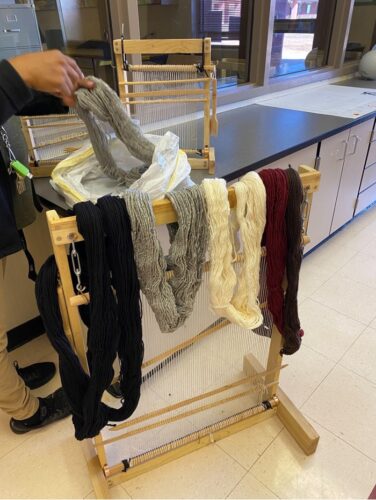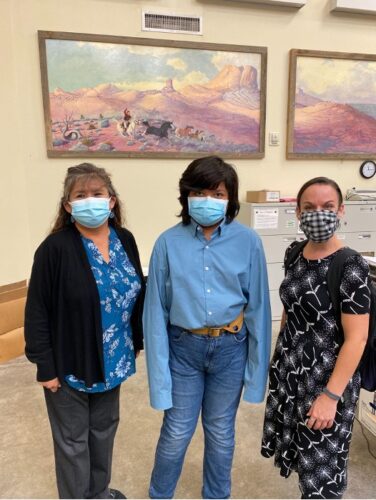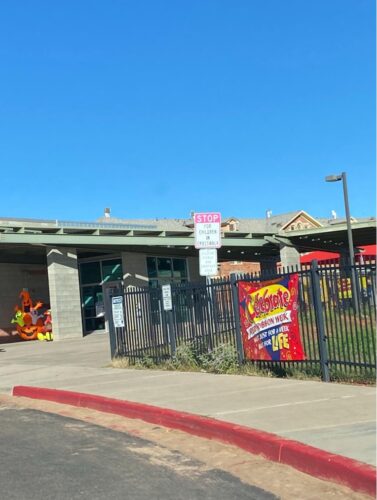There is nothing like getting to meet with our volunteer coordinators and hear their stories directly about how they are helping children in their communities, thanks to our sponsors and donors. Today we hear from Renée Kube, our Director of U.S. Programs, as she meets with four special coordinators who run our sponsorship program at Pinon Community School in Arizona, who explain the lengths they are willing to go to to help kids in need.
“On the tour, I had the chance to see some of the great projects that Children Incorporated funded over the years!”
about Pinon
“The small town of Pinon, Arizona is about 45 miles due west of Chinle on Indian Road 4. The population is sparse and spread out in this area, giving it a more remote feeling than some of the other towns where our affiliated sites are located,” said Renée.
“The Pinon Community School itself is a mix of newer buildings, as well as some of the original 1932 structures. This school is set up in a similar manner to our affiliated site, the Hanaadli Community School/Huerfano Dorm, in New Mexico, in which some children live on-site during the week and some return home after school each day.”
“Education starts with a FACE Program, which stands for Family and Child Education. This is a federal program that focuses on Native families, providing educational services from prenatal to five years of age by providing early childhood education, parenting education, and adult education. After FACE, the child can go on to kindergarten,” said Renée.

Students learn weaving skills at Pinon Community School, which is a big part of their culture and heritage.
“There are two options for kindergarten: a regular kindergarten, and a developmental kindergarten for children with late birthdays (from September through December). Kindergarten is instructed in both English and Navajo. After kindergarten, the children are educated at the local Pinon Unified School District. The dorm students either live at a greater distance than daily transportation allows, or their parents or guardians work out of town for extended periods of time. Pinon Community School also offers the 21st Century Learning Center for afterschool care. The dorm serves 1st through 12th grades.”
“When I arrived to the school, I checked in at the main office, and soon was taken to the conference room. I was greeted by our primary coordinator, Carol, who then introduced me to the other three staff members who serve on the ‘Children Incorporated Committee’: Cassandra, Chyanne, and Rainey,” said Renée.
Readjusting after the pandemic
“While we met, the four ladies shared how challenging things were for them during the pandemic. While the children were participating in fully virtual instruction, the sponsorship funds were being used mostly for food. They are grateful there is a grocery store in the community, although Bashas is small and has limited selection. The ladies explained that the nearest Walmarts are located in Winslow, Arizona (94 miles south) or Gallup, New Mexico (120 miles southeast). It is very humbling to realize how far they travel – using their own vehicles – to shop for the children in our sponsorship program.”
“The school did not re-open for in-person instruction until March 2022. Before the pandemic, 86 children were enrolled. In March, just 30 students returned. Now the number has risen, slowly but steadily, to 70,” said Renée.
“The dorm has not yet re-opened. The old HVAC system was on its last legs, and a new system [with the goal of improving ventilation and preventing respiratory infections] will cost $4 million dollars. This is partly due to the age of some of the buildings; the oldest were built in the 1930s.”
There is nothing like getting to meet with our volunteer coordinators and hear their stories directly about how they are helping children in their communities, thanks to our sponsors and donors.
“We then began our tour of the buildings and grounds. Our coordinators explain that it’s considered bad form and manners to walk directly across the courtyard; instead, one is supposed to walk around, unless one is specifically using the middle structure. They’re always having to remind the children.”
seeing our projects in person
“On the tour, I had the chance to see some of the great projects that Children Incorporated funded over the years! The Reading Pavilion Project in the courtyard was an area with benches where the children really enjoy sitting with their books. An annual vine is trained over the top each spring to provide shade. I also got to see the School Garden Project. We provided funds to purchase materials for the raised beds and fencing, and supplies including soil, fertilizer, seeds, and hand tools. Crops have been planted every spring, and it is used by the science teacher as well as the dormitory staff for instruction and enrichment activities for the children,” said Renée.
“Then we went inside. We went to a classroom and were shown samples from the Weaving Project, whose materials and supplies were provided thanks to our Hope In Action Program. Beginners learn on simple cardboard looms with inexpensive yarns. The small, medium, and large wooden looms are used as the children gain experience and proficiency. They’ll move over time from loom to loom. They use fewer yarn colors on the smaller looms, and add more yarn colors as they progress.
The advanced learners are using the largest looms, the highest quality yarns, and the most colors,” said Renée.
***
How do I sponsor a child with Children Incorporated?
You can sponsor a child in one of three ways: call our office at 1-800-538-5381 and speak with one of our staff members; email us at sponsorship@children-inc.org; or go online to our sponsorship portal, create an account, and search for a child that is available for sponsorship.
SPONSOR A CHILD




